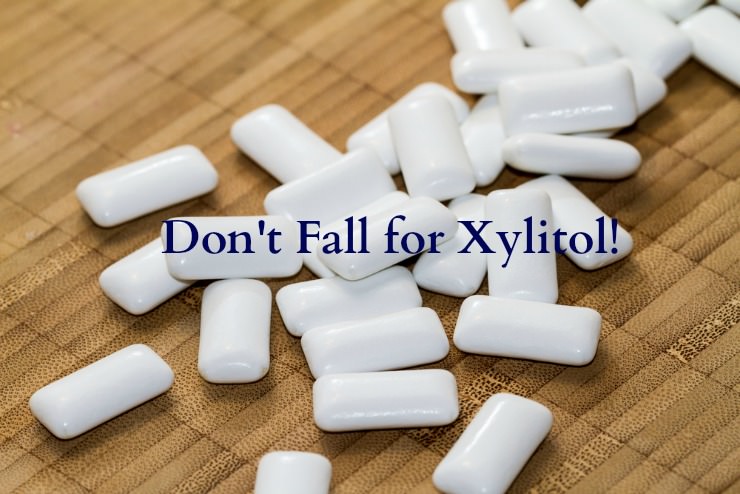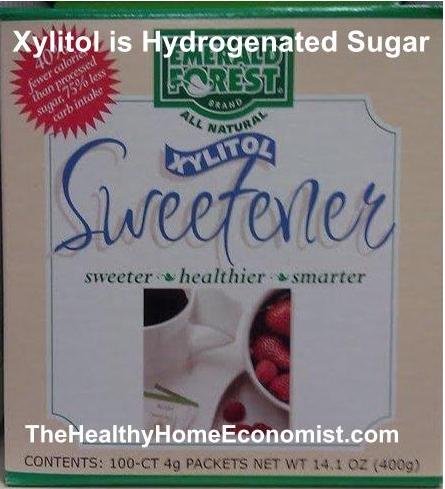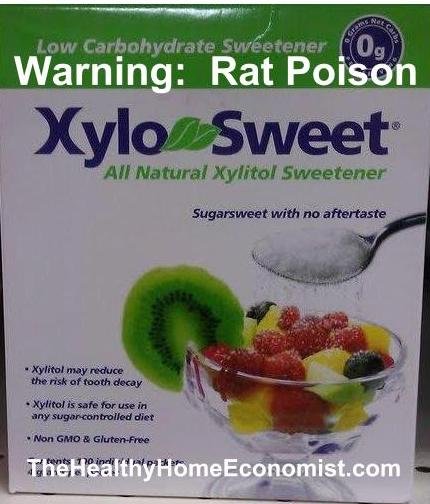
Xylitol is truly the darling of sugar substitutes today. The American Dietetic Association touts its use, with this sugar alcohol sold alone and as a sweetener in a variety of processed foods. Health benefits include a reduced glycemic response compared with sucrose, increased absorption of B vitamins and calcium, and even a reduction in dental caries risk.
Consequently, people with blood sugar issues are flocking to processed foods containing this alternative sweetener as a way to satisfy that sweet tooth without the downside of exacerbating the risk factors for Metabolic Syndrome. This condition is known for the markedly increased likelihood of developing heart disease, stroke, and type 2 diabetes.
Even the healthfood community almost universally considers this sugar alcohol to be a healthy substitute for sugar. A primary reason is that it doesn’t directly contribute toward the growth of intestinal yeasts aka Candida.
Have you noticed that the check out aisles at health food stores are typically loaded with chocolates and other sweets containing at least some xylitol? The truth is that I have yet to talk with any health-conscious person who suggests to me any downside other than the potential for intestinal cramps if you get too much.
Xylitol is Naturally Found in Nature
Xylitol is, after all, a naturally occurring substance. Manufacturers of xylitol market it as derived from xylan. The fibers of many plants contain it, including berries, oats, beets, sugar cane and birch. Sounds pretty harmless at first glance.
The FDA has even granted xylitol GRAS (Generally Recognized As Safe) status. You can’t get any safer than that, right?
 Manufacturing Process
Manufacturing Process
It is true that xylitol is a naturally occurring substance. However, manufactured xylitol is another matter entirely. Food manufacturers produce it using the industrialized process of sugar hydrogenation. In order to hydrogenate anything, a catalyst is needed. In this case, Raney nickel is used which is a powdered nickel-aluminum alloy. (1, 2)
This poses the risk of heavy metal residue and contamination. Nickel, by the way, is a recognized carcinogen and aluminum is associated with the development of dementia. Heavy metals in the body are notoriously difficult to eliminate with frequent use of infrared sauna probably a good idea.
This alternative sweetener doesn’t seem quite so warm and fuzzy anymore, does it?
There is currently no literature on any detrimental health effects of consuming hydrogenated sugar. However, food manufacturers widely used hydrogenated fats for decades before the very damaging effects of cardiovascular health became widely known!
Given the violent industrialized process that is required to produce a hydrogenated sugar like xylitol, it would seem wise to avoid it based on the very poor track record of hydrogenated foods in general.
Most Xylitol Sourced from GMO Corn
While it is true that xylitol can be derived from the xylan of birch trees, xylan is also found in corn cobs. It is much cheaper to use corn instead of birch bark to derive xylitol and so what do you think manufacturers prefer? Corn, of course.
Therefore, unless the label of a xylitol-containing product specifically notes that it is from birch or another nonGMO source, xylitol is very likely from genetically modified corn or possibly GMO sugar beets.
This is the same problem as high fructose corn syrup (HFCS) and white sugar from beets. Food manufacturers rely heavily on these sweeteners in the production of sodas and sports drinks.
You get a dose of GMOs with every sip! More on GMO dangers including sterility and stomach holes at the provided link.
Usage Contributes to Gut Imbalance
The digestive process does not break down sugar alcohols like food. Rather, xylitol arrives intact into the intestines.
At that point, a process called “passive diffusion” takes place. This means that the xylitol draws water into the bowels. Only a partial breakdown is the end result. The unmetabolized portion ferments providing the perfect environment for undesirable bacteria to thrive and grow.
It is true that xylitol itself does not feed candida directly as sugar does. As a result, this artificial sweetener is even promoted as a useful part of the Candida Diet. Unfortunately, the fermentation of undigested xylitol in the gut most definitely can exacerbate yeast problems. Don’t be fooled by this argument!
This is exactly why consuming xylitol can make some folks so gassy and even trigger cramping and diarrhea. Gut pathogens having a heyday in your intestines give off a lot of smelly toxins!
Other Little Known Problems
Xylitol can contribute to acid reflux problems. As a result, those who have issues in this area should avoid it for that reason alone. Chronic acid reflux is a serious problem that can lead to cancer of the esophagus and larynx.
In addition, those who suffer from seizures of any kind should stay away from this alternative sweetener as it can increase the frequency of epileptic attacks.
Two Pieces of Xylitol Gum Can Kill a Rat?
According to unpublished lab tests, approximately 1.65 grams of xylitol kills a 100-gram rat half the time.
Two little pieces of xylitol gum contain about .7 – 1 gram. This is probably enough to meet the definition of rat poison.

Cavity Prevention
Many people are chewing xylitol gum due to compelling scientific evidence for cavity prevention. What about children, however?
Rami Nagel, author of Cure Tooth Decay, doesn’t even recommend xylitol gum for this purpose. His research for any long term safety data turned up the following:
- Epidemiology: No information found
- Teratogenicity: No information found
- Reproductive Effects: No information found
- Mutagenicity: No information found
- Neurotoxicity: No information found
In summary, using this modern substance officially renders you a guinea pig, my friend! It seems that any benefits of cavity prevention are outweighed by the fact that there is no actual safety data backing up its use.
Safe Uses of Xylitol
Given all the problems that consumption of xylitol can trigger, it seems best to bypass the use of this sugar substitute on a regular basis.
Can it ever be helpful? Does it have any benefits whatsoever?
Potentially so. The only time I personally would ever consider using xylitol is to help resolve a childhood ear or sinus infection in order to prevent the use of drug-based antibiotics.
There is evidence that this popular sugar alcohol can indeed help encourage a healthy balance of beneficial bacteria found in the ear canal and sinus cavities. Products like this incorporate xylitol for this purpose.
A therapeutic dose can help resolve infection in these areas quickly with no medication required.
Thus, if you choose to use it, make sure it is sparingly and therapeutically (not as food). Also, make sure it does not come from a GMO source like corn!
References
(1) Xylitol production via catalytic hydrogenation of sugarcane
(2) Catalytic hydrogenation of xylose to xylitol using ruthenium catalyst on NiO modified TiO2 support
(3) Cure Tooth Decay by Rami Nagel
(4) Sugar-Free Blues: Everything You Wanted to Know about Artificial Sweeteners
More Information
Yacon: Healthy Syrup or Healthfood Hype?
Jaggery: India’s Sweet Gift








You are correct J Onehcud that the GMO concerns re xylitol are unwarranted. This is well covered here along with other xylitol misconceptions:
Of course if is your choice whether to use it yourself, but re any possible digestive issues, there is this:
http://4noguilt.com/facts-about-xylitol
Metabolic & Chemical features of Xylitol: The caloric content of Xylitol is approximately the same as that of “sugar,” however; it is not as well absorbed with approximately 25-33% staying in the GI tract where it is metabolized by gut flora. When a significant amount is consumed at once, only about 1/3 will be absorbed through the gut wall, thereby traveling to the liver via the portal vein, the rest stays in the GI tract and is utilized by the beneficial intestinal flora and broken down into SCFAs (short chain fatty acids) which are vital to proper gut cell metabolism. Significant quantities will cause transient soft stools (osmotic diarrhea). Once a person has become adapted to Xylitol, amounts up to 200+ grams per day can readily be tolerated without causing diarrhea.
A quick note on GMO:
I think it is truly wonderful to see people taking such an active interest in the foods they consume. As a PhD candidate researching diabetes, I was considering trying xylitol in some Christmas baking for family members with type 2 diabetes with the goal of keeping their blood sugar in check over the holidays. Given the risk for intestinal discomfort and the scarcity of safety testing I have decided against it. Who want’s diarrhea at Christmas?
However, I would like to share a bit about how I understand GMOs and why, with respect to xylitol from GMO corn, the GMO issue may not be as relevant as you might think. It all starts with DNA, the stuff in every cell of any living thing that serves as the master instructions for all of our cellular and body functions. The DNA is where all of our genes are. In a GMO, specific instructions (genes) in the DNA have been altered to produce a desirable outcome such as pesticide resistance, growth properties etc… As you very clearly pointed out xylitol extraction from plants (including corn) requires extensive industrial processing to arrive at the “purified” xylitol. As such, the only thing you end up with is the xylitol, not the GMO gene product that helps it survive pesticides, not the GMO gene product that helps it grow better….just the xylitol. So unless the corn is being genetically modified to specifically produce more or somehow better xylitol, the GMO argument is in my opinion irrelevant. You are not getting the altered DNA or any of the altered gene products in the final product.
I’m not a GMO employee, or even a GMO supporter for that matter, just a scientist who believes people deserve to really understand what they are putting in their bodies. Although I don’t think the GMO argument holds much weight in rationalizing if this product is for you, I will be choosing to avoid xylitol.
You’re a PhD candidate and you say “who want’s?” Scary.
I am a former high-school grammar teacher, college-composition instructor, and professional writer. Even I make mistakes.
Just FYI: you cannot bake with xylitol – it doesn’t react with yeast.
You don’t actually need (table) sugar/honey.. for yeast to react with. Sugar is nothing more than a catalyst in the process. Yeast is going to react with ANY carbohydrate (found in every kind of flour, even in paleo types) it just needs a bit more time to do so.
To people who are talking about what to use when baking for diabetics: it doesn’t matter. Baked goods are not a good idea for diabetics at all. Even a slice of bread can be just as bad as a snickers bar.
I use Xylitol for quite some time now and I haven’t experienced any side effects by now. However, I think I use it in a moderate way. Usually I use it to substitute some sugar in baked stuff like cakes, muffins or brownies (especially when the recipe calls for a lot of sugar). It’s not that I eat sweet stuff all the time but there are some days every now and then when I have this craving for something sweet.
When I heard the first time about Xylitol I read and researched a lot about it before I decided to try it. I haven’t heard about this rat tests mentioned above but I know that Xylitol is highly toxic to dogs (and supposedly cats too). I don’t have pets so this is not issue for me.
As far as I know, the canine body and the human body react completely different to Xylitol. The human body can easily distinct between sugar and Xylitol. The canine body however reacts on Xylitol or sugar the same way. Its pancreas is triggered to release insulin, a lot of insulin. This rapid release of insulin results in a rapid and profound decrease in the level of blood sugar (hypoglycemia). The dosage needed to cause this effect is fairly low and can be life-threatening to the pet quickly.
However, this toxic effect for some animals should not be confused with the effects on humans. But pet owners should be aware of it and be careful with products containing Xylitol.
As I said above, I use Xylitol for quite a while now and no side effects at all. I think whatever we eat or drink, it should be balanced well. The same applies to fat or sugar which can be a normal part of our diet as long as everything is well balanced. In my opinion it would be stupid to avoid any sugar or replace it completely with other sweeteners. On the other hand consuming loads of sugar every day isn’t very smart either. My sister is a pharmacist and she always tells me that almost everything whether considered healthy or not can kill you if the dosage is just high enough (even vitamins or minerals).
If I have a glas of wine or two in the evening I will be perfectly fine the other morning. If I drink a whole bottle or more I will most likely wake up with a headache.
Some really in-depth info on xylitol benefits:
http://4noguilt.com/facts-about-xylitol
Jenifer, Thank you for taking the time to provide us with the rest of the story.
This discussion has been very spirited with all sides believing they are right.
For me it is all about making an informed decision, with all the information and
opinions here it has helped me proceed cautiously. In the end it seems that
moderation is key and protecting our pets from finding any Xylitol is a must.
Adding Xylitol to my oral hygiene seems to be a good way to introduce Xylitol
into my world. Good oral health leads to better overall health, if Xylitol can help
I’m all in. Have a great day.
We are all going to die for some reason or another sooner or later, so worrying about occasionally using of any naturally claimed sweetners (not to be confused with Aspertame, sucrolose, sucrose, HFCS etc and any thing….obviously carsinogenic) should be trivial within the big picture of life. I recently discovered our new local frozen yogurt shop uses xylitol in their products. I have a cup seldom and find it is delicious compared to any of the other sweeteners used in other frozen yogurt treats. So, the old adage states; “Everything In Moderation” worry less about penny-ante issues, enjoy our existence as we pass through this short journey in the ways of the world and don’t sweat the small stuff.
I find it so interesting that people buy/use things that they don’t research themselves. I appreciate the blog but it does not really address that the good xylitol is birch. Naturopathic dentists are having patients use xylitol more and more. Poisonous to dogs due to the fact they do not have the same digestive enzymes as humans……obviously not able to digest things like we can and vice versa! As far as humans having digestion issues, anything you read about it will tell you basically that if your gut isn’t that healthy this will probably cause a poop-a-palooza.
And just remember, no blog post the the “IT” of info, there can be stuff that isn’t included that really should be.
Where did you get the information about “And, while it is true that xylitol itself does not feed candida directly like sugar does and is even promoted as a useful part of the Candida Diet, the fermentation of undigested xylitol in the gut most definitely can exacerbate yeast problems, so don’t be fooled by that argument!”
I have not been able to find the research that backs this up and I am very interested to read about this.
This is word for word from Ramiel Nagel. Sounds like all residues are removed.
1. First the xylan needs to be broken down in a process called acid hydrolyzing. The results of this process leave us with xylose and acetic acid. The process of hydrogenation is carried out at higher pressures and temperatures ranging from 158 degrees Fahrenheit and higher. Hydrogenation needs a catalyst, so a substance called Raney nickel can be used which is a powdered nickel-aluminium alloy.
2. The acetic acid needs to be removed as the material safety data sheet describes it as, “Very hazardous in case of skin contact (irritant), of eye contact (irritant), of ingestion, of inhalation. Hazardous in case of skin contact (corrosive, permeator), of eye contact (corrosive).”
3. Then the hydrolyzing acid and organic residues must be removed, this is done by heating the mixture and evaporating it.
4. The resulting syrup, now free of acetic acid, hydrolyzing acid, nick-aluminum and other residues.
5. The syrup is crystallized by stirring ethanol into it.
6. The crystalline xylitol is now separated in a centrifuge from the ethanol and from the sorbitol remaining in solution.
7. Viola, you have xylitol.
Who is Ramiel Nagel? And where is this article, so that we all can read it if we would like. Most of your sources seem to come from http://www.NaturalNews.com, Amazon.com and your own site – not a whole lot of different sources.
A stick of xylitol gum can also kill a dog, which should be noted in your argument. But that, however, changes the rat argument to conclude that it’s probably something other than the size and it’s more to do with the difference in make up (ie dogs and chocolate).
I think the key is everything in moderation. It’s still better than aspertame.